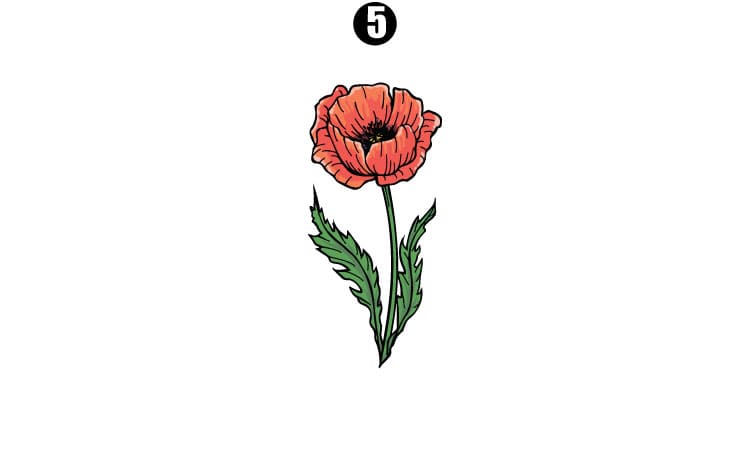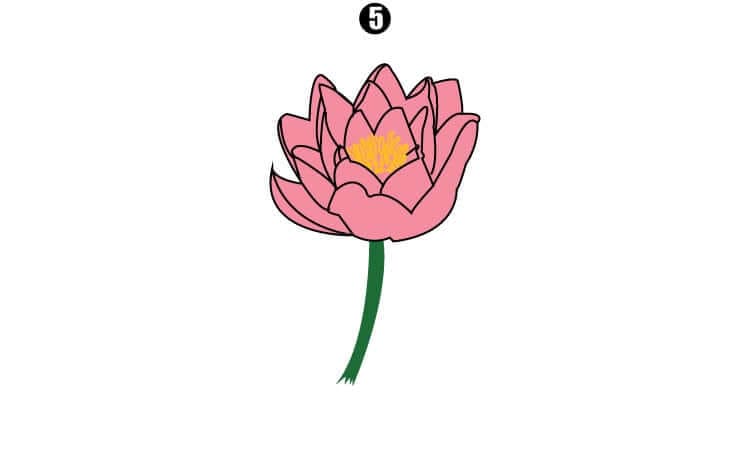How to Draw a Poppy
Poppies are rich blossoms known for their fragile petals and lively tones, frequently representing recognition and harmony. Drawing a poppy can be a satisfying encounter, permitting you to catch its extraordinary excellence. This exhaustive aide will walk you through the most common way of drawing a poppy bloom bit by bit, guaranteeing that you make a shocking and sensible portrayal. How about we dig into the captivating universe of poppies and begin on our creative excursion!
Step 1: Gathering Your Materials
Before you start drawing, accumulate every one of the vital materials. Having the right apparatuses will make the interaction smoother and more agreeable.
- Drawing Paper: Utilize great quality drawing paper that can deal with both pencil and ink.
- Pencils: A scope of pencils from HB (for outlining) to 2B or 4B (for concealing) will be helpful.
- Eraser: A decent quality eraser for revising mix-ups and easing up lines.
- Sharpener: Save your pencils sharp for exact lines.
- Fine-tip Pen or Marker: For illustrating the last drawing.
- Shaded Pencils, Pastels, or Markers: For adding variety to your drawing.
Step 2: Understanding the Poppy Structure
Prior to beginning your drawing, pause for a minute to comprehend the essential design and life systems of a poppy blossom. Here are a few vital highlights to note:
- Petals: Poppy petals are enormous, adjusted, and frequently have a crinkled surface. They are organized in layers, giving the bloom a full appearance.
- Focus: The focal point of the poppy comprises of a noticeable disgrace encompassed by stamens, which are slim, fragile designs.
- Stem: The stem is typically lengthy, slim, and somewhat bended.
- Leaves: Poppy leaves are lobed and have a marginally spiked edge.
- Seed Case: After the blossom sprouts, poppies foster unmistakable seed units, which are oval and have a finished surface.
Step 3: Sketching the Basic Shapes
Begin by outlining the essential shapes that will frame the underpinning of your poppy drawing. Involving a pencil for this step will consider simple changes.
- Bloom Head: Start by drawing an enormous, roundabout shape in the focal point of your paper. This will address the principal a piece of the poppy blossom.
- Stem: Draw a long, marginally bended line broadening downwards from the lower part of the circle to address the stem.
- Leaves: Draw a few wide, lobed shapes reaching out from the foundation of the stem to address the leaves. Position the leaves at various points to add authenticity.
Step 4: Drawing the Petals
The petals are the most unmistakable piece of the poppy, so take as much time as is needed to guarantee they are drawn precisely and perfectly.
- Focus Petal: Begin by drawing the focal petal. This petal ought to be enormous, adjusted, and marginally crinkled. The edges ought to be lopsided to mirror the normal surface of the petals.
- Side Petals: Draw the side petals covering the focal petal. These petals ought to be comparable in shape however situated at various points to make a feeling of profundity.
- Back Petals: Add the back petals to some degree taken cover behind the focal and side petals. These petals ought to be more modest and less definite since they are farther away.
Step 5: Drawing the Centre of the Poppy
The focal point of the poppy is where you can add many-sided subtleties to make your drawing more sensible.
- Shame: Draw a little, roundabout shape in the focal point of the blossom to address the disgrace. Add little spots or lines around it to emulate the surface.
- Stamens: Draw slim, bended lines emanating outwards from the disgrace to address the stamens. Every stamen ought to have a little, adjusted tip. Organize the stamens equitably around the middle to make a full, balanced appearance.
Step 6: Drawing the Stem and Leaves
The stem and leaves are fundamental pieces of the poppy, giving differentiation and setting to the bloom head.
- Stem Shape: Refine the state of the stem, making it marginally thicker at the base and tightening towards the top. Add delicate bends to copy the normal development of the stem.
- Leaf Shape: Refine the states of the leaves, making them more particular and proportionate. Each leaf ought to be expansive, lobed, and somewhat pointed at the tips.
- Leaf Veins: Add veins to the leaves by defining bended boundaries emanating outwards from the focal point of each leaf. These veins ought to be light and unpretentious to imitate the normal surface of the leaves.
Step 7: Refining the Drawing
Presently, refine your drawing by adding more subtleties and making acclimations to work on the general appearance.
- Petal Surface: Add light, bended lines on the petals to address the normal surface and crinkling. These lines ought to follow the form of every petal and be unobtrusive to try not to overwhelm the fragile appearance.
- Leaf Surface: Add little, barbed lines along the edges of the leaves to address their regular surface. These lines ought to be light and unpredictable to impersonate the normal appearance.
- Shadow and Profundity: Add concealing to the petals, leaves, and stem to make a feeling of profundity and three-dimensionality. Utilize a milder pencil (2B or 4B) to add shadows where the petals cross-over and around the foundation of the leaves.
Step 8: Outlining Your Drawing
Cautiously frame the whole drawing with a fine-tip pen or marker. This will make your drawing stick out and give it a spotless, completed look.
- Smooth Lines: Guarantee the lines are smooth and even, and really focus on the subtleties and surfaces.
- Strong Lines: Utilize bolder lines for the external edges and lighter lines for the inward subtleties to make a feeling of profundity and ordered progression in your drawing.
Step 9: Coloring Your Poppy
Presently comes the tomfoolery part – adding variety to your poppy! Pick splendid and bright varieties to rejuvenate your drawing.
- Petal Tone: Poppy petals are normally red, orange, or pink. Utilize a light shade for the base shade of the petals and add hazier shades for profundity and concealing. For an exemplary red poppy, utilize various shades of red and a touch of dark or brown for the shadows.
- Stem and Leaf Tone: Utilize various shades of green to variety the stem and leaves. Begin with a light green for the base tone and add hazier green for the veins and edges to make a practical surface. Add a brown or yellow to the edges to address normal maturing and defects.
- Focus Tone: Utilize dark or dull brown for the focal point of the poppy, adding lighter shades for features and profundity.
Step 10: Adding a Background
A basic foundation can improve your poppy drawing and make it seriously captivating. The following are a couple of thoughts:
- Field of Poppies: Attract extra poppies the foundation to make a field of blossoms. Utilize lighter tones and less detail for the foundation blossoms to make a feeling of profundity.
- Sky Foundation: Draw an unmistakable blue sky or a nightfall to supplement the dynamic shades of the poppy. Use slopes of blue, orange, and pink to make a practical sky.
- Straightforward Foundation: On the off chance that you favor a moderate look, you can leave the foundation clear or add a light wash of variety to feature the poppy without overpowering it.
Step 11: Final Touches
Before you finish, pause for a minute to survey your drawing and add any last contacts to consummate your poppy.
- Frames: In the event that any blueprints have blurred during shading, go over them with a fine-tip dark pen or marker to make them fresh and understood. This will assist with characterizing the shapes and highlights of your poppy.
- Features and Shadows: Add last features and shadows to improve the three-layered impact. Utilize a white pencil or marker to include little features the petals, leaves, and stem. Add shadows under the petals and passes on to ground your poppy in its current circumstance.
- Survey: Investigate your attracting to guarantee all that looks adjusted and proportionate. Make any important acclimations to improve the general appearance of your poppy.
Step 12: Displaying Your Artwork
Whenever you’ve completed your poppy drawing, now is the ideal time to show your work of art! The following are a couple of thoughts:
- Outlining: Spot your attracting a casing and drape it on the wall. This will safeguard your fine art and give it an expert look.
- Release Board: Pin your attracting to a notice board where everybody can see it. This is an extraordinary way to grandstand your work and motivate others to begin drawing.
- Craftsmanship Portfolio: Add your attracting to a workmanship portfolio to keep it protected and coordinated. This will likewise permit you to glance back at your advancement after some time.
Conclusion
Drawing a poppy blossom is a tomfoolery and compensating imaginative undertaking that can assist you with fostering your drawing abilities and release your innovativeness. By following these means, you can make a definite and exact drawing that catches the excellence and polish of poppies. Keep in mind, the main piece of attracting is to partake simultaneously and allowed your imagination to sparkle. Try not to stress over making everything great; all things being equal, center around putting yourself out there and having a good time. Cheerful drawing!
You May Also Like:
Bird Drawing cute




